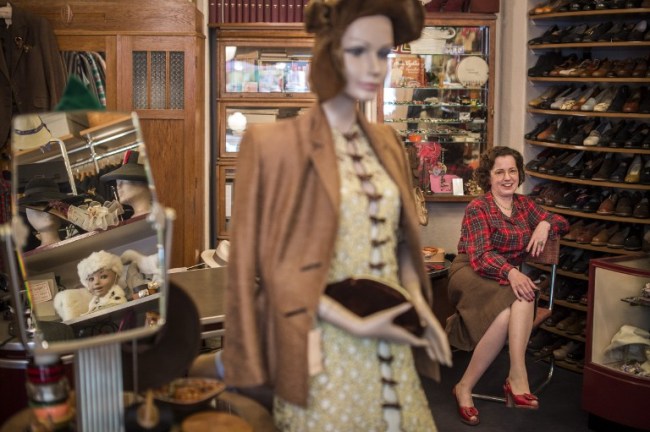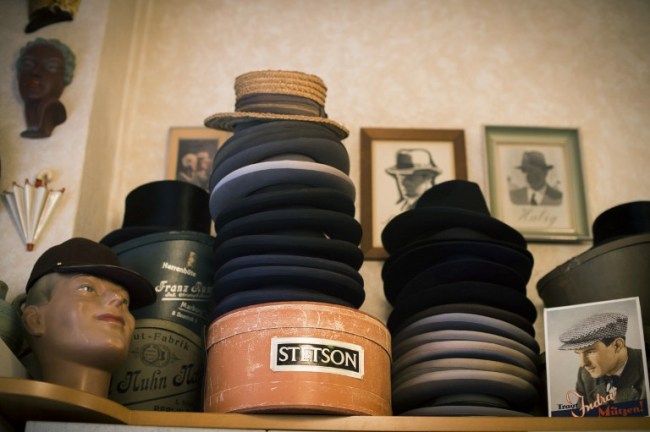Berlin passion for ’40s fashion untempered by WWII hue
By Korea HeraldPublished : Sept. 17, 2014 - 20:40
BERLIN (AFP) ― With her blotted red lipstick, perky coiffed curls and fitted 1940s skirt suit, Constanze Pelzer looks like she’s stepped off a World War II film set.
From head to toe, the 49-year-old German is the picture of 1940s elegance ― from the little glasses and striking jewelry to her red sling-backs, her entire outfit is authentic.
But it isn’t a costume.
Despite bringing to mind a painful chapter of German history, Pelzer admires 1940s fashion so much that she wears originals from the era every day and is not alone in her sartorial dedication.
“It’s, at once, the fabrics, the colors, the workmanship, the high quality,” she told AFP at her 1920s-1950s vintage shop, off Berlin’s upscale Kurfuerstendamm shopping avenue.
From head to toe, the 49-year-old German is the picture of 1940s elegance ― from the little glasses and striking jewelry to her red sling-backs, her entire outfit is authentic.
But it isn’t a costume.
Despite bringing to mind a painful chapter of German history, Pelzer admires 1940s fashion so much that she wears originals from the era every day and is not alone in her sartorial dedication.
“It’s, at once, the fabrics, the colors, the workmanship, the high quality,” she told AFP at her 1920s-1950s vintage shop, off Berlin’s upscale Kurfuerstendamm shopping avenue.


“I don’t feel at all like I’m in disguise, in this fashion of the past. I just feel right,” she said.
Forties fashion conjures up the full-throttle glamour of Lauren Bacall or other Hollywood sirens.
But the era that saw Europe riven by war after the rise of the Nazis in Germany heralded utilitarian clothes for ordinary women ― practical but polite knee-length skirts, wide-leg trousers and a shapelier silhouette.
“Great fashion, but a terrible time too for many people,” added Pelzer, who said she was inspired by the ‘soldiering on’ spirit in which women had defied shortages and devastation to look chic.
Fellow vintage lover Tina Buettner, 40, said that contradictions in 1940s fashion only deepened her fascination.
“I don’t identify myself now with German ideals of the time,” she said, adding that what she loved about 1940s style flew in the face of the Hitler regime’s “perfect woman.”
“They didn’t want the sculpted, rouged diva, but rather the wife at the stove, having as many children as possible ... in plaits and simple, practical clothes.
“In fact, the opposite of what’s fun about this,” the Berlin resident said.
Both women said 1940s vintage was now an international trend and part of the fun was meeting up with other addicts in Germany and elsewhere at themed dances and dinners.
Fantasy versus real
Cultural historian Mila Ganeva, of Miami University in the U.S., said 1940s fashion was rich and multifaceted, from the war and postwar periods, to Christian Dior’s cinched, full-skirted “New Look” in 1947.
“It offers a lot, counter to our images of war, hunger, deprivation, material shortages,” she said in a telephone interview.
During the war, German women mostly made their own clothes, recycling tablecloths, uniforms and menswear, she said.
But their imaginations were stoked by the more sophisticated styles of the movie screen, newsreels or magazines, shrewdly tolerated by the Nazis as a morale booster.
“In no period of time was there ever such a spectrum of fashion between the imaginary and the real,” the expert on German film and fashion said.
-
Articles by Korea Herald








![[Kim Seong-kon] Democracy and the future of South Korea](http://res.heraldm.com/phpwas/restmb_idxmake.php?idx=644&simg=/content/image/2024/04/16/20240416050802_0.jpg&u=)








![[KH Explains] Hyundai's full hybrid edge to pay off amid slow transition to pure EVs](http://res.heraldm.com/phpwas/restmb_idxmake.php?idx=652&simg=/content/image/2024/04/18/20240418050645_0.jpg&u=20240418181020)

![[Today’s K-pop] Zico drops snippet of collaboration with Jennie](http://res.heraldm.com/phpwas/restmb_idxmake.php?idx=642&simg=/content/image/2024/04/18/20240418050702_0.jpg&u=)